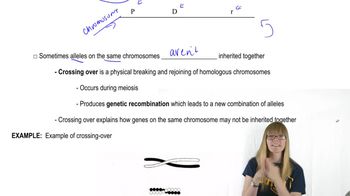Alleles A and a are on one pair of autosomes, and alleles B and b are on a separate pair of autosomes. Does crossover between one pair of homologs affect the expected proportions of gamete genotypes? Why or why not? Does crossover between both pairs of chromosomes affect the expected gamete proportions? Why or why not?
Table of contents
- 1. Introduction to Genetics51m
- 2. Mendel's Laws of Inheritance3h 37m
- 3. Extensions to Mendelian Inheritance2h 41m
- 4. Genetic Mapping and Linkage2h 28m
- 5. Genetics of Bacteria and Viruses1h 21m
- 6. Chromosomal Variation1h 48m
- 7. DNA and Chromosome Structure56m
- 8. DNA Replication1h 10m
- 9. Mitosis and Meiosis1h 34m
- 10. Transcription1h 0m
- 11. Translation58m
- 12. Gene Regulation in Prokaryotes1h 19m
- 13. Gene Regulation in Eukaryotes44m
- 14. Genetic Control of Development44m
- 15. Genomes and Genomics1h 50m
- 16. Transposable Elements47m
- 17. Mutation, Repair, and Recombination1h 6m
- 18. Molecular Genetic Tools19m
- 19. Cancer Genetics29m
- 20. Quantitative Genetics1h 26m
- 21. Population Genetics50m
- 22. Evolutionary Genetics29m
4. Genetic Mapping and Linkage
Crossing Over and Recombinants
Problem 19
Textbook Question
If the cross described in Problem 18 were made, and if Sb and cu are 8.2 map units apart on chromosome III, and if 1000 offspring were recovered, what would be the outcome of the cross, assuming that equal numbers of males and females were observed?
 Verified step by step guidance
Verified step by step guidance1
Determine the recombination frequency between the Sb and cu genes. Since they are 8.2 map units apart, the recombination frequency is 8.2%, or 0.082. This means that 8.2% of the offspring will be recombinant, while the remaining 91.8% will be parental types.
Calculate the expected number of recombinant offspring. Multiply the total number of offspring (1000) by the recombination frequency (0.082). This will give the total number of recombinant offspring.
Divide the recombinant offspring into two equal groups, as there are two types of recombinant gametes (one with Sb and the other with cu). Each recombinant type will represent half of the total recombinant offspring.
Calculate the expected number of parental offspring. Subtract the number of recombinant offspring from the total number of offspring (1000). The remaining offspring will be parental types. Divide this number into two equal groups, as there are two types of parental gametes (one with Sb and cu together, and the other with neither Sb nor cu).
Summarize the expected outcome of the cross by listing the number of offspring for each genotype or phenotype category (two parental types and two recombinant types). Ensure that the total adds up to 1000.
 Verified video answer for a similar problem:
Verified video answer for a similar problem:This video solution was recommended by our tutors as helpful for the problem above
Video duration:
1mPlay a video:
Was this helpful?
Key Concepts
Here are the essential concepts you must grasp in order to answer the question correctly.
Genetic Mapping
Genetic mapping is a method used to determine the location of genes on a chromosome and the distance between them. The distance is often measured in map units, where 1 map unit corresponds to a 1% chance of recombination occurring between two genes during meiosis. In this case, the distance of 8.2 map units between the Sb and cu genes indicates a relatively low likelihood of recombination, which affects the expected offspring ratios.
Recommended video:
Guided course

Mapping Overview
Recombination Frequency
Recombination frequency refers to the proportion of offspring that exhibit a combination of traits different from those of the parents due to crossing over during meiosis. It is calculated based on the number of recombinant offspring divided by the total number of offspring. In this scenario, with a recombination frequency of 8.2%, we can predict the expected ratios of parental and recombinant phenotypes among the 1000 offspring.
Recommended video:
Guided course

Recombination after Single Strand Breaks
Punnett Square and Expected Ratios
A Punnett square is a diagram used to predict the genetic makeup of offspring from a cross between two individuals. By applying the recombination frequency to the Punnett square, we can calculate the expected phenotypic ratios of the offspring. Given the genetic distance and the total number of offspring, we can derive the expected numbers of each phenotype resulting from the cross.
Recommended video:
Guided course

Chi Square Analysis
Related Videos
Related Practice
Textbook Question
496
views


